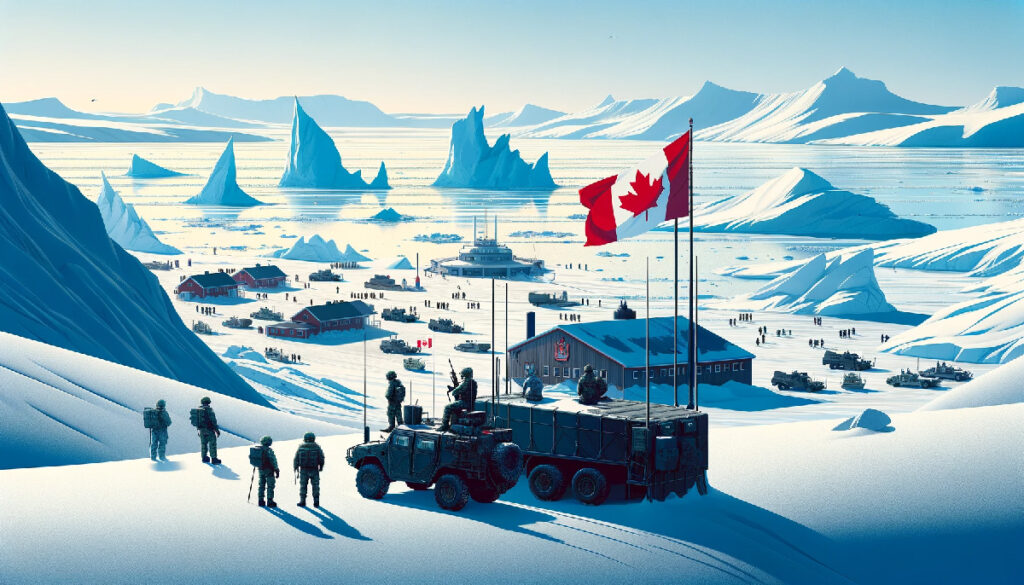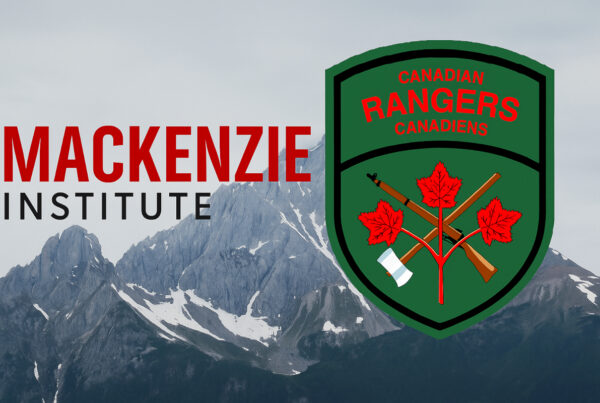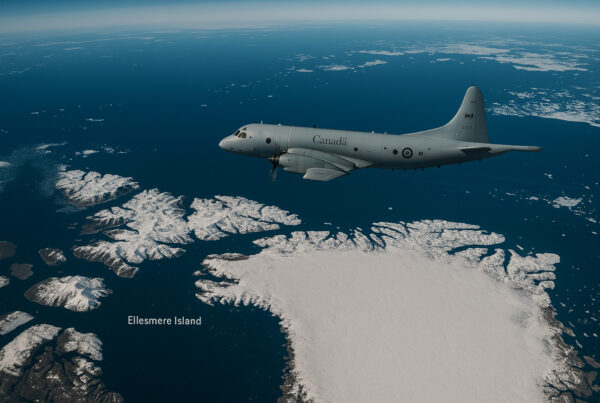
Canadian Forces in winter gear in the Arctic – DALL-E 3
(Written by Carter Jack Lewis)
A warming Arctic Ocean presents myriad new challenges to Canadian policy and international cooperation, especially with regard to disappearing sea ice and the new trade routes that are now open almost all year round, such as the Northwest Passage. Canada boasts the most northern permanently inhabited place on the planet in the form of Canadian Forces Station ‘Alert’ located on Ellesmere Island in Nunavut. It is only 817km away from the North Pole and houses about 55 full-time military and civilian personnel.[1]
Canada’s ally and Arctic as well as southern neighbour, the United States, espouses narratives that vary administration to administration; however, the underlying theme is that America will always prioritize its own interests in the Arctic as well as elsewhere. Canada ought to do the same and could work with the U.S. to respect the sovereignty of the Northwest Passage, as there are forces in the world that would aim to drive a wedge between North American cooperation and exploit any rift.
China and Russia are also challenging Canadian sovereignty in the Arctic. China intends to utilize the Northwest Passage for cargo shipping, as it is 30% faster than the route through the Panama Canal.[2] Russia has been maneuvering to increase its arctic transportation corridor, territory and claims to natural resources.[3] It is thus perhaps wise to grow the footprint, readiness, and ability of the Canadian military to defend the land and waterways of the Far North, while working with international partners to strengthen NATO, NORAD and improve Canadian overall preparedness and territorial integrity.
Maintaining a substantial permanent presence throughout the Canadian Arctic presents several significant challenges due to the harsh environmental conditions and remote location. Some of the main difficulties include:
Security Concerns:
The strategic importance of the Arctic region has led to increased attention on security issues. Maintaining a permanent base involves considering both natural elements and potential geopolitical adversaries. The Arctic is the closest route for long range bombers, ICBM’s, drones, submarines, ships, and supposed weather balloons from global adversaries to reach North America’s backyard. The international Arctic Council is the main intergovernmental forum that promotes cooperation in the region; it is made up of the following countries: Canada, Denmark, Finland, Iceland, Norway, Russia, Sweden and the United States. Seven of its eight members are now also members of NATO. It is imperative that Canada combines a strategy that encompasses both hard power in the form of military deterrence and soft power through diplomacy to ensure that Canada’s sovereignty is respected in the Arctic and in particular throughout the Northwest Passage.
Extreme Weather Conditions:
Life-threatening cold, strong winds, ice, and heavy snowfall are unavoidable problems that hinder the construction and maintenance of infrastructure. The freeze-thaw cycle can also cause damage to buildings and equipment. Due to the extreme weather conditions, there are limited windows of opportunity for construction and maintenance activities. Harsh winters and ice cover can restrict access and the time available for materials delivery, building and repairs, requiring careful scheduling and planning. Canada has experience with small scale of construction in this region, with mixed success; however, as the footprint of projects increase so too do the challenges of supporting such endeavours.
Technological Challenges:
Harsh weather conditions can impact the performance of technology and communication systems. Maintaining reliable communication links and operational technology is crucial for the safety, connectivity and functionality of any base.
Logistics and Remoteness:
The Arctic is vast and sparsely populated, making regional travel, transportation and logistics challenging. The remote location and lack of infrastructure mean that accessing the area can be expensive and logistically complex. Limited transportation options can hinder the timely delivery of supplies and equipment. Keeping a military base fully stocked with fuel and other necessary supplies is a complex and arduous task adding to the existing support requirements of existing civilian communities. The isolation, weather and darkness pose additional potential for strain on mental health. Regional military bases should operate under arctic-theatre specific guidelines that address the unique challenges of living and defending the great northern expanses of Canada. Historically, the Canadian Northwest Passage has been more navigable than the Russian Northern Sea Route, which runs along the Russian Arctic coast, due to harsher ice conditions and less developed infrastructure. However, the status quo is changing with the Russian northern passage now more open as the climate warms and Russia invests in its Arctic infrastructure.
Limited Resources and Environmental Sensitivity:
The Arctic, like everywhere on Earth, has a finite amount resources, and establishing a permanent base requires careful planning for the sustainable use of available resources. Classified as a desert due to its lack of precipitation, a consistent water supply is key to any project in the Far North. Additionally, energy sources and waste management must be considered to ensure any base is viable long-term without negatively impacting the fragile Arctic ecosystem.
Wildlife and Environmental Protection:
The Arctic is home to diverse and sensitive ecosystems. Establishing a base in this region requires careful consideration of its environmental impact. Strict regulations are in place to protect the Arctic environment and its wildlife, and adherence to these regulations adds another layer of complexity to operating in the region.
Permafrost and Land Transportation Issues:
Fifty percent of Canada’s land mass is covered in permafrost, meaning it remains permanently frozen throughout the year.[4] Building on permafrost requires specialized construction techniques to prevent ground settling and infrastructure damage. In recent years, climate scientists have reported that “permafrost temperatures are rising at a much faster rate than the temperature of the air in the Arctic and have risen between 1.5 to 2.5 degrees Celsius in the last 30 years.”[5] The melting of permafrost in the Arctic would exacerbate an already warming climate, “destroying infrastructure”[6] and irreversibly impacting the terrain and biodiversity of the Arctic. A possible solution to overcoming the challenges of permafrost and the fragile arctic ecosystems are the use of balloon tires, also known as low-pressure or flotation tires, which can potentially reduce the impact on the Arctic environment in various ways:
Lower Ground Pressure: Balloon tires have a larger footprint and distribute the vehicle’s weight over a larger area. This results in lower ground pressure, reducing the impact on the fragile Arctic ecosystems. This is particularly important in areas with permafrost, as high ground pressure can cause soil disturbance and contribute to the thawing of permafrost.
Reduced Soil Compaction: The low-pressure design of balloon tires reduces soil compaction. In the Arctic, where the soil structure is delicate and vegetation is adapted to harsh conditions, minimizing soil compaction helps to preserve the natural environment.
Enhanced Floatation: The large surface area of balloon tires allows vehicles to “float” on soft surfaces like snow and mud rather than sinking in. This is beneficial in Arctic environments where the ground is often covered with snow or has a soft, marshy consistency. By minimizing sinking, these tires help prevent damage to the underlying terrain.
Less Impact on Vegetation: Balloon tires are less likely to damage vegetation compared to traditional tires with smaller footprints. In the Arctic, where plant life is adapted to slow growth rates, any damage to vegetation can have long-lasting effects. Balloon tires help to minimize this impact.
Improved Traction: Balloon tires are designed to provide better traction on soft surfaces. This is beneficial in Arctic environments where icy and snowy conditions are common. Improved traction can enhance vehicle control, reducing the likelihood of slipping and sliding, which could lead to environmental damage.
Adaptability to Changing Conditions: Balloon tires are versatile and can adapt to various terrains and weather conditions. In the Arctic, where environmental conditions can change rapidly, having tires that perform well in different scenarios can contribute to minimizing the impact on the ecosystem.
While balloon tires offer advantages in reducing environmental impact, it’s essential to note that the overall environmental impact of any activity in the Arctic should be carefully managed. Even with balloon tires, responsible and sustainable practices, such as minimizing vehicle traffic and using designated routes, are crucial to preserve the delicate Arctic ecosystems.
Partnership with Local Communities:
A crucial aspect to overcoming the countless hurdles posed by inhabiting the Arctic must be the involvement and incorporation of Inuit expertise and interests. Keeping in consideration the recognized sovereignty of these peoples, the federal government should seek to partner and consult with this population to better understand the region and foster mutually beneficial relationships that advance the interests of all parties.
Addressing the aforementioned challenges requires a multidisciplinary approach involving legal and judicial matters, engineering, environmental science, logistics, military-civil cooperation, local and international partnerships. As climate change continues to affect the Arctic, these challenges may evolve, emphasizing the need for adaptive and sustainable solutions that prioritize the Canadian security and national defense of all its peoples.
Sources:
Bykova, Alina. “Permafrost Thaw in A Warming World: The Arctic Institute’s Permafrost Series Fall-Winter 2020.” The Arctic Institute – Center for Circumpolar Security Studies, 21 Apr. 2023, www.thearcticinstitute.org/permafrost-thaw-warming-world-arctic-institute-permafrost-series-fall-winter-2020/.
Dowd, Allan, and Alexander Moens. “Meeting Russia’s Arctic Aggression: Op-Ed.” Fraser Institute, 23 Apr. 2018, www.fraserinstitute.org/article/meeting-russias-arctic-aggression.
Leslie, Anthony. “Arctic Permafrost Is Thawing. Here’s What That Means for Canada’s North – and the World.” Canadian Geographic, 2 Apr. 2019, canadiangeographic.ca/articles/arctic-permafrost-is-thawing-heres-what-that-means-for-canadas-north-and-the-world/.
Rutherford, Nicole. “China Looks to Use Northwest Passage for Faster Shipping.” Canadian Geographic, 25 Apr. 2016, canadiangeographic.ca/articles/china-looks-to-use-northwest-passage-for-faster-shipping/.
“Ice Charts.” The Northwest Passage, thenorthwestpassage.info/ice-charts. Accessed 27 Nov. 2023.
Royal Canadian Air Force. “Canadian Forces Station Alert.” Government of Canada, 27 Feb. 2019, www.canada.ca/en/air-force/corporate/alert.html.
[1] Royal Canadian Air Force. “Canadian Forces Station Alert.” Government of Canada, 27 Feb. 2019
[2] Rutherford, Nicole. “China Looks to Use Northwest Passage for Faster Shipping.” Canadian Geographic, 25 Apr. 2016.
[3] Dowd, Allan, and Alexander Moens. “Meeting Russia’s Arctic Aggression: Op-Ed.” Fraser Institute, 23 Apr. 2018.
[4] Leslie, Anthony. “Arctic Permafrost Is Thawing. Here’s What That Means for Canada’s North – and the World.” Canadian Geographic, 2 Apr. 2019,
[5] Bykova, Alina. “Permafrost Thaw in A Warming World: The Arctic Institute’s Permafrost Series Fall-Winter 2020.” The Arctic Institute – Center for Circumpolar Security Studies, 21 Apr. 2023
[6] Bykova, Alina. “Permafrost Thaw in A Warming World: The Arctic Institute’s Permafrost Series Fall-Winter 2020.” The Arctic Institute – Center for Circumpolar Security Studies, 21 Apr. 2023








